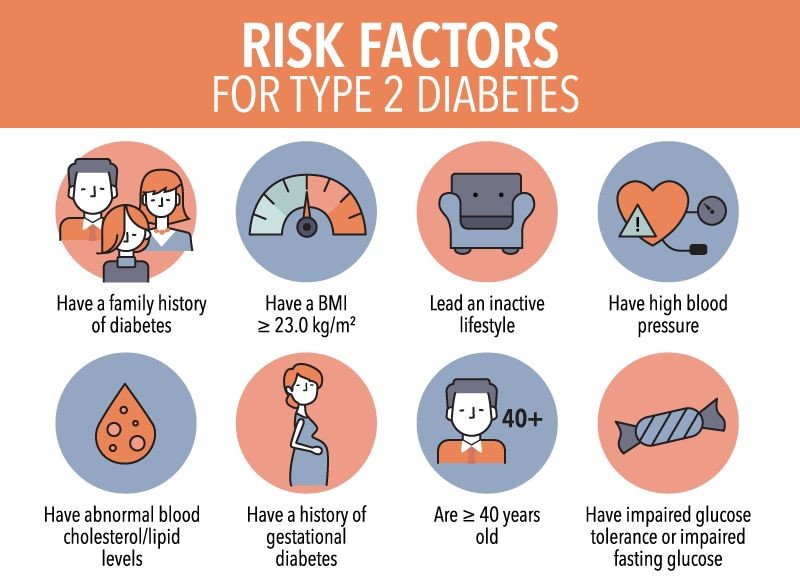
Contents
- 1 Can a Fit Person Get Diabetes? Risk Factors
Can a Fit Person Get Diabetes? Risk Factors
You can still get diabetes no matter how thin or fit you are. About 10%-15% of people with type II diabetes are at a healthy weight, a condition called lean diabetes.
Visceral fat, which grows around your organs, can be present even if you do not have visible fat. So even people who appear healthy on the outside may still be at risk of developing conditions like diabetes.
What is diabetes?
Diabetes is a chronic metabolic disorder that affects the way your body converts food into energy.
The majority of the carbs you consume is converted to sugar and absorbed into your circulation. Increased blood sugar levels prompt your pancreas to release insulin, a hormone that allows blood sugar to enter cells and be used as energy.
In diabetes, your body either does not produce enough insulin or does not effectively use it. This leads to excessive blood sugar in your bloodstream, which can result in major health issues over time, such as heart disease, vision loss, and kidney problems.
What are risk factors for diabetes?
Risk factors for diabetes depend on the type:
Type I diabetes risk factors
Although the specific cause of type I diabetes is unknown, the following factors may indicate a higher risk:
- Family history. If you have a parent or sibling with type I diabetes, you are at higher risk.
- Environmental factors. Exposure to viral diseases, for example, is likely to play a role in the development of type I diabetes.
- Geography. Type I diabetes is more common in some countries, such as Finland and Sweden.
Prediabetes and type II diabetes risk factors
Researchers are not sure why some people get prediabetes and type II diabetes while others do not. However, certain factors can increase the risk:
- Family history. If you have a parent or sibling with type II diabetes, your risk increases.
- Ethnicity. African, Hispanic, American Indian, and Asian American ethnicities are more vulnerable to the disease.
- Age. Risk increases with age, potentially due to reduced exercise, muscle loss, and weight gain. Type II diabetes is also becoming more common in younger populations.
- Weight. Increased fatty tissue causes cells to become insulin resistant.
- Inactivity. Less physical activity leads to a greater risk. Exercise helps burn glucose for energy and makes cells more insulin-sensitive.
- Diabetes during pregnancy. Gestational diabetes increases the likelihood of developing prediabetes and type II diabetes later in life. Infants weighing over 9 pounds also pose a risk for type II diabetes.
- Polycystic ovarian syndrome (PCOS). PCOS increases the risk of diabetes in women and is marked by irregular menstrual cycles, excessive hair growth, and obesity.
- Abnormal cholesterol and triglyceride levels. Low levels of high-density lipoprotein (HDL) or "good" cholesterol and high levels of triglycerides increase the likelihood of type II diabetes.
QUESTION
What are the different types of diabetes?
There are different types of diabetes, and it is important to determine which type you have in order to successfully treat and manage it.
- Type I diabetes: This occurs when your body cannot produce insulin, resulting in abnormally high blood sugar levels. Your body continues to break down carbs into glucose, but there is no insulin to allow the glucose into your body’s cells. As a result, glucose accumulates in the system, increasing blood sugar levels.
- Type II diabetes: With type II diabetes, your body does not produce enough insulin or properly utilize it, causing excessive glucose in your blood. It can occur at any age, particularly in middle-aged and older individuals, and symptoms often appear gradually over time.
- Prediabetes: Prediabetes is a condition in which blood glucose levels are higher than normal but not high enough for a diabetes diagnosis. Most people with type II diabetes initially have prediabetes.
- Gestational diabetes: Gestational diabetes affects pregnant women when their bodies do not produce enough insulin or respond well to it. It occurs in 2%-10% of pregnancies each year.
What are the symptoms of diabetes?
Diabetes symptoms vary depending on the severity. Some patients with prediabetes or type II diabetes may not have any symptoms. However, type I diabetes symptoms are typically more severe and noticeable.
Common symptoms of diabetes include:
- Frequent urination
- Increased thirst
- Increased hunger
- Fatigue
- Blurry vision
- Delayed wound healing
- Patches of dark skin, especially on the back of the neck and in the armpits or groin
How is diabetes diagnosed?
Accurate diagnosis of diabetes is crucial for proper management. Tests used to diagnose the condition include:
- Fasting plasma glucose test: Measures your blood glucose levels after an 8-hour fast. Blood sugar levels indicate the following:
- Normal: 99 mg/dL
- Prediabetes: 100 to 125 mg/dL
- Diabetes: 126 mg/dL or higher
- Normal: 140 mg/dL
- Prediabetes: 140 to 199 mg/dL
- Diabetes: 200 mg/dL or higher
- Normal: Less than 140 mg/dL
- Prediabetes: 140 to 199 mg/dL
- Diabetes: 200 mg/dL or higher
How is diabetes treated?
Treatment for diabetes depends on the type. Blood sugar monitoring, insulin, and oral medications may all be part of the treatment plan.
- Treatment of type I diabetes includes insulin injections or an insulin pump, regular glucose checkups, and dietary modifications.
- Treatment of type II diabetes includes lifestyle changes, blood glucose monitoring, diabetes medications, and insulin.
Balanced eating, maintaining a healthy weight, and regular exercise are crucial for managing and controlling diabetes. Consider the following factors:
- Eat healthy: Under your doctor’s advice, develop a diabetes meal plan. Reduce intake of saturated fat, trans fat, sugar, and salt. Consume fiber-rich foods such as whole grains, fruits, and vegetables. Opt for water instead of juice or sugary drinks.
- Monitor your calories: If taking medication, track your total calories for each meal and adjust your medications accordingly. Monitor your meals and blood sugar levels 2 hours after eating to identify which foods affect your blood sugar the most.
- Stay active: Engage in at least 5 days of exercise per week. Begin with short walks throughout the day, incorporate strength training twice a week, and engage in other physical activities.
Subscribe to MedicineNet’s Diabetes Newsletter
By clicking "Submit," I agree to the MedicineNet Terms and Conditions and Privacy Policy. I also consent to receive emails from MedicineNet and understand that I may opt out of subscriptions at any time.
By clicking "Submit," I agree to the MedicineNet Terms and Conditions and Privacy Policy. I also consent to receive emails from MedicineNet and understand that I may opt out of subscriptions at any time.


